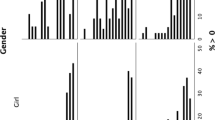Abstract
This article discusses the prevalent crisis in secondary school counselling and suggests a new model to change the role, priorities, and activities of a school counsellor from a peripheral to the central position.
Similar content being viewed by others
References
American Association for Counselling and Development (1987).School Counselling, A Profession at Risk: The Report of the AACD School Counselling Task Force. Alexandria, VA: Author.
American School Counsellor Association (1988).Position Statement: The School Counsellor and School/student Ratio. Alexandria, VA: Author.
Aubrey, R.F. (1993). Excellence, school reforms, and counsellors. In J. Carlson & J. Lewis (eds.),Counselling the Adolescent: Individuals, Family, and School Interventions (2nd ed.) (pp. 221–236). Denver, CO: Love Publishing Company.
Baker, S.B. (1992).School Counselling for the Twenty-first Century. New York: Macmillan Publishing Company.
Bandura, A. (1977).Social Learning Theory. Englewood Cliffs, N.J.: Prentice-Hall.
Barret, R.L. & Schmidt, J. (1986). School counsellor certification and supervision: Overlooked professional issues.Counsellor Education and Supervision 26: 50–55.
Bonebrake, C. & Bergers, S. (1984). Counsellor role as perceived by counsellors and principals.Elementary School Guidance & Counselling 18: 194–198.
Brown, D. (1989). The perils, pitfalls, and promises of school counselling program reform.The School Counsellor 37: 47–53.
Commission on Precollege Guidance and Counselling (1986).Keeping the Options Open: Final Report Recommendations. New York: College Entrance Examination Board.
Dye, H.A. & Borders, L.D. (1990). Counselling supervisors: Standards for preparation and practice.Journal of Counselling and Development 69: 27–32.
Gardner, D. (1983).A Nation at-Risk: The Imperative for Educational Reform. Washington, DC: U.S. Department of Education.
Gorton, R. & Ohlemacher, R. (1987). Counsellor evaluation: A new priority for the principal's agenda.NASSP-Bulletin 71(96): 120–124.
Gross, D. & Staino, E. (1988). Where have all the counsellors gone: A way for administrators to prevent extinction.The Early Adolescence Magazine 2(5): 38–40.
Gysbers, N.C. (1990).Comprehensive Guidance Programs That Work. Ann Arbor, MI: ERIC Counselling and Personnel Services Clearinghouse.
Gysbers, N.C. & Henderson, P. (1988).Developing and Managing Your School Guidance Program. Alexandria, VA: American Association for Counselling and Development.
Hallohan, J.J. (1990). School counselling includes a ‘daily hyphen.’The School Counsellor 37: 245–247.
Hart, P.A. & Jacobi, M. (1992).From Gatekeeper to Advocate: Transforming the Role of the School Counsellor. New York: College Entrance Examination Board.
Helliwell, C.B. & Jones, G.J. (1975). Reality considerations in guidance program evaluation.Measurement and Evaluation in Guidance 8: 155–162.
Herr, E.L. (1984). The national report on reform in schooling: Some missing ingredients.Journal of Counselling and Development 63: 217–220.
Hitchner, K.W. & Hitchner-Tifft, A. (1987).A Survival Guide for the Secondary School Counsellor. West Nyack, NY: The Center for Applied Research in Education, Inc.
Housley, W.F., McDaniel, L.C. & Underwood, J.R. (1990). Mandated assessment of counsellors in Mississippi.The School Counsellor 37: 294–302.
Krumboltz, J.D. (1974). An accountability model for counsellors.Personnel and Guidance Journal 52: 639–646.
Kurpius, D. & Rozecki, T. (1992). Outreach, advocacy, and consultation: A framework for prevention and intervention.Elementary School Guidance and Counselling 26: 176–189.
McGowan, S. (1993, November). Many school counselling programs cut when finances run low.Guidepost 36(5): 1, 8.
Moles, O.C. (1991). Guidance programs in American high schools: A descriptive portrait.School Counsellor 38: 163–177.
Morse, C.L. & Russell, T. (1988). How elementary counsellors see their role: an empirical study.Elementary School Guidance and Counselling 23: 54–62.
Nugent, F.A. (1994).An Introduction to the Profession of Counselling (2nd ed.). New York: Macmillan College Publishing Company.
Partin, R.L. (1993). School counsellor's time: Where does it go?The School Counsellor 40: 274–281.
Peer, G.G. (1985). The status of secondary school guidance: A national survey.The School Counsellor 32: 181–187.
Pietrofesa, J.J. & Vriend (1971).The School Counsellor as a Professional. Itasca, IL: F.E. Peacock Publishers.
Shields, C. (1986). Good public relations is good for business (and guidance department too).The School Counsellor 34: 144–146.
Shertzer, B. & Stone, S.C. (1981).Fundamentals of Guidance (4th ed.). Boston, MA: Houghton Mifflin Company.
Thomas, M.D. (1989). The role of the secondary school counsellor.The School Counsellor 36: 249–252.
Vacc, N.A., Rhyne-Winkler, M.C. & Poidevant, J.M. (1993). Evaluation and accountability of counselling services: Possible implications for a mid-size school district.The School Counsellor 40: 260–266.
Walz, G.R. (1991). Forces for change in counselling and counsellor education. In G.R. Walz, G.M. Gazda & B. Shertzer (eds.),Counselling Futures (pp. 39–59). Ann Arbor, MI: ERIC Counselling and Personnel Services Clearinghouse.
Wilson, N.S. (1985). School counsellors and research: Obstacles and opportunities.The School Counsellor 33: 111–119.
Author information
Authors and Affiliations
Rights and permissions
About this article
Cite this article
Sandhu, D.S., Portes, P.R. The proactive model of school counselling. Int J Adv Counselling 18, 11–20 (1995). https://doi.org/10.1007/BF01409600
Issue Date:
DOI: https://doi.org/10.1007/BF01409600




